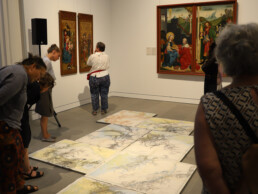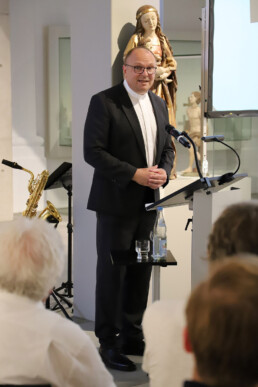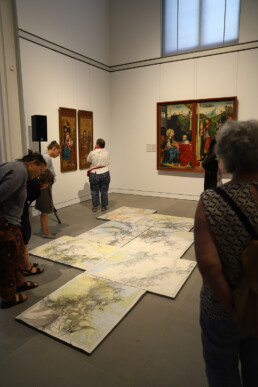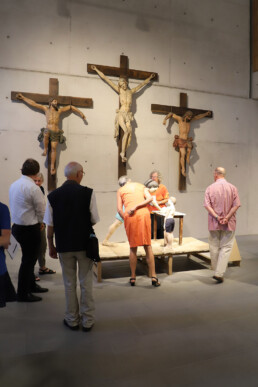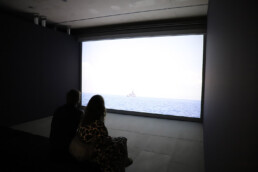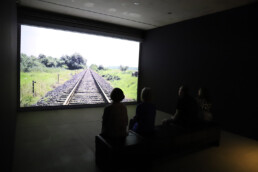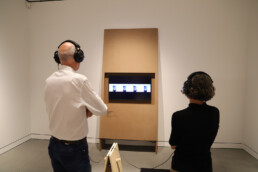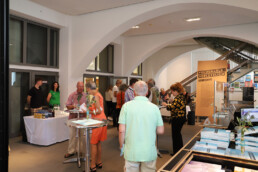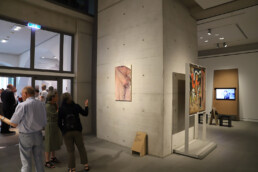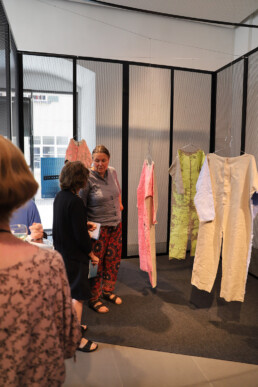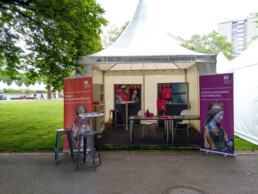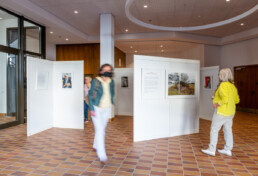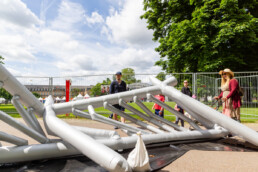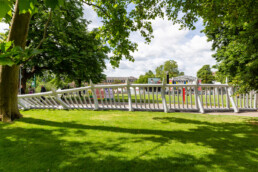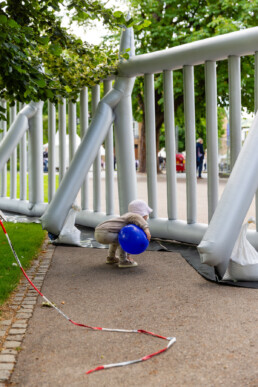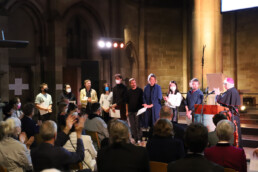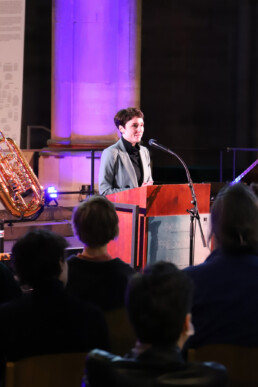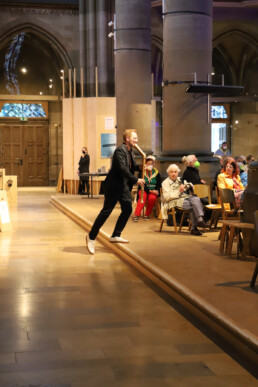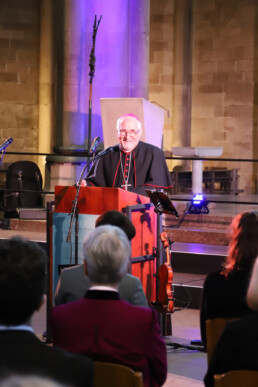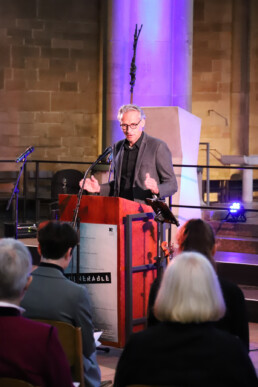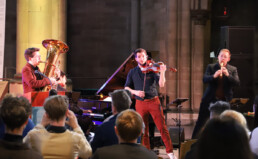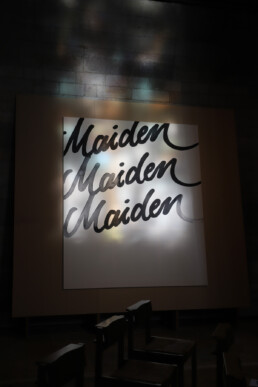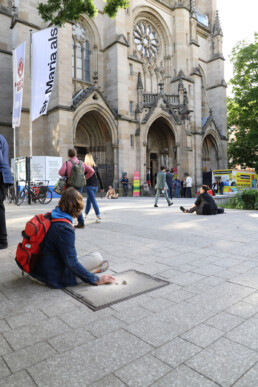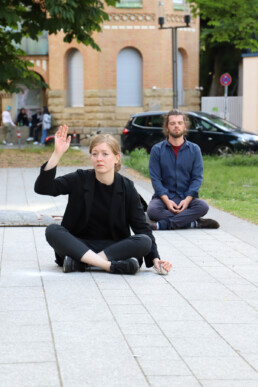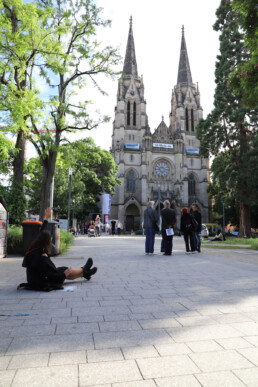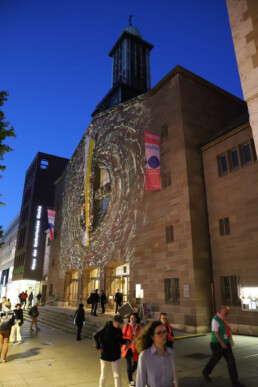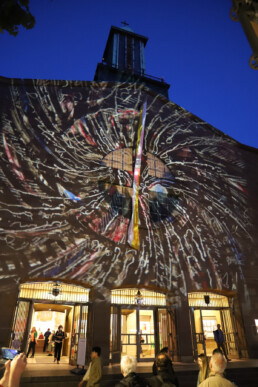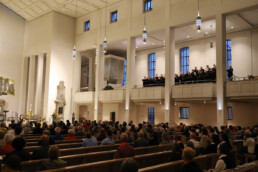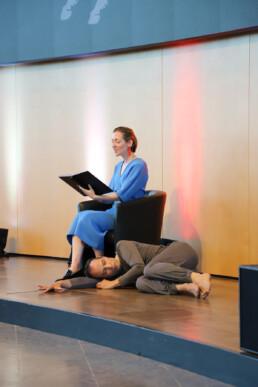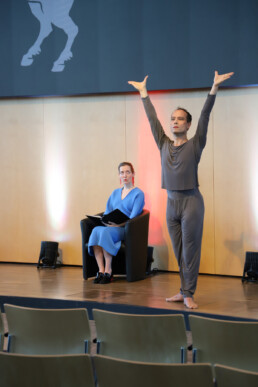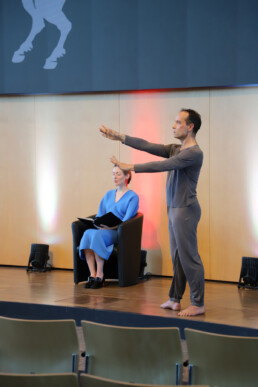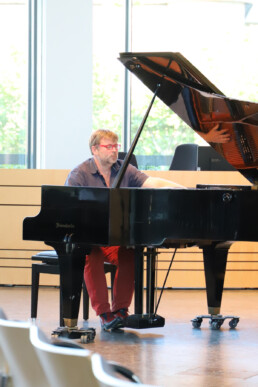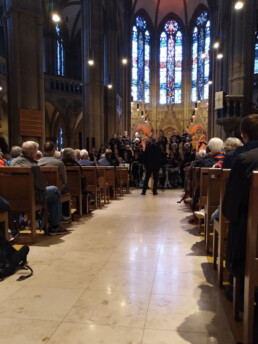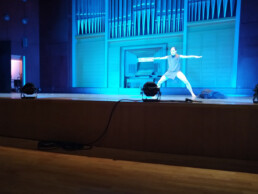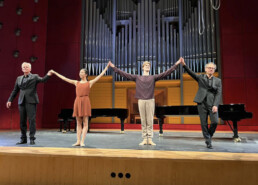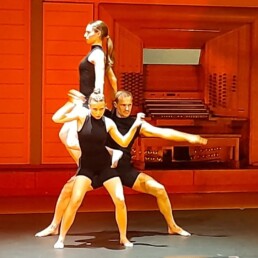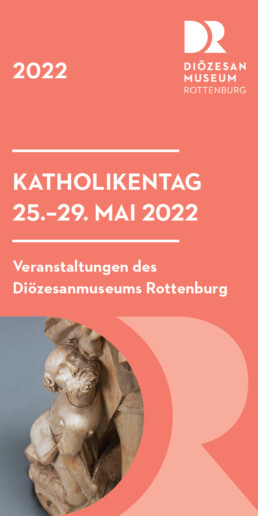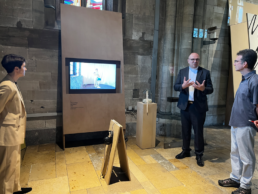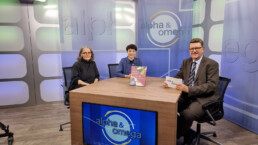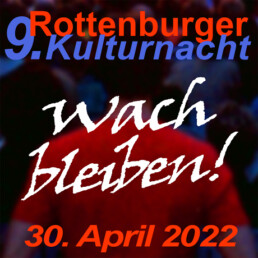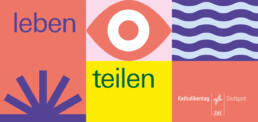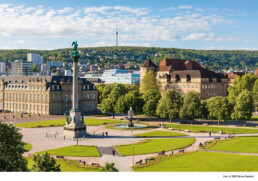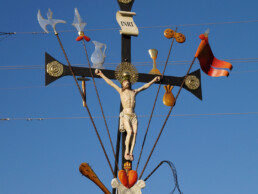Vernissage „Vulnerable“
The special exhibition “Vulnerable” goes into the next round: last Sunday, 19.06, after St. Mary’s, now the second part of the exhibition was ceremoniously opened in the Diocesan Museum! After a varied programme – with musical accompaniment by Anna Ohlmann – the guests were able to get a first impression of the winning entries of the art competition (including the three main prize winners). The team of the Diocesan Museum would like to thank everyone for the lively interest and the stimulating exchange!
Catholic Day 2022
Catholic Day 2022
The team of the Diocesan Museum looks back on an eventful, interesting and colourful Katholikentag. The museum was able to organise a total of two exhibitions and eight cultural events, and was also represented with its own stand in the Stadtgarten. The response was positive throughout! The vernissage in St. Mary’s, where the winners of the art competition “Vulnerable” were honoured by Bishop Fürst, the photo exhibition “Next door” in St. Agnes as well as the diverse artistic and musical offerings in the city met with great interest. The events stimulated exchange and reflection, but also invited people to celebrate and marvel. We would like to thank all the cooperation partners and the numerous artists for their commitment and good cooperation, which also made the Katholikentag a success for art and culture!
We make art strong in times of crisis
At the Katholikentag in Stuttgart, award-winning works from the art competition "Vulnerable" will be on display for the first time in St. Maria's from 27 May.
The competition had met with a great response: Around 600 artists applied, 25 young creatives were selected. They dealt with the vulnerability of human life in a variety of ways.
“The pandemic and most recently the war in Ukraine have brutally torn us out of what we take for granted in life,” says Auxiliary Bishop Dr Gerhard Schneider, who is also responsible for art in the Diocese of Rottenburg-Stuttgart. “It is difficult to put this much-cited ‘turn of time’ into words. For us as a church, it is important to make art strong, especially in times of crisis like these. Art offers ways to express, find and orient oneself in the unknown and always incomprehensible events of our time – especially where words are no longer able to do so.”
Achieving two kilometres of distance with one step
The works are correspondingly diverse in their form of presentation. For example, Simon Pfeffel’s video performance “Mit einem Schritt” (With one step), which won him one of the first prizes, shows how he covered the approximately two-kilometre distance from Stuttgart’s main railway station to St. Mary’s with just one step. “To do this, the artist tied one of his legs up and then hopped and limped his way through Königsstraße,” reports Sebastian Schmid, theologian and curator of St. Maria’s, who was part of the interdisciplinary competition jury along with nine other people.
Schmid: “Simon Pfeffel was clear that he would not make it without the help of strangers. Nevertheless, he didn’t ask anyone for help. Only when passers-by in Stuttgart offered to support him did he let themselves be carried or propped up. The exhibition shows video recordings of this impressive action, in which he put himself at the mercy of strangers.”
The motto of the Katholikentag also stands for being vulnerable together
The director of the Diocesan Museum in Rottenburg, Dr Melanie Prange, who was responsible for the competition and also a member of the jury, is pleased that the exhibition will now be opened during the Katholikentag. “Our works of art fit particularly well with the motto ‘sharing life’ of the Katholikentag, because all people are vulnerable, because vulnerability is precisely the essential moment of human existence and God has exposed himself to this vulnerability. Together we are vulnerable and it is especially in togetherness that paths to healing are paved. The motto of the Katholikentag brings essential thoughts of our competition and exhibition theme once again to the point.”
Kriz Olbricht wants to show with his artwork that the church itself is also vulnerable. To do this, he has hammered five dividing wedges into the wall of St. Maria. These are a kind of nails that normally create cracks in stones.
“It took a lot of convincing before the artist was allowed to hammer these dividing wedges into the wall of the church,” Schmid reports. “Just the idea that there could be a crack in the church wall almost caused panic in some people. The congregation itself was the least afraid.” The parish council immediately understood what Olbricht was about, he says. “After all, the five nails in the chancel stand for questions like: How seriously does the church take the cross? Does it dare to make itself vulnerable? Does it risk its own structure to take the side of the wounded?”, the theologian explains further.
Exhibition on view in Stuttgart from 27 May to 24 July
Visitors to the exhibition can look forward to nine more works of art, which will be on display in St. Mary’s from 27 May to 24 July. Dr. Prange is pleased that the exhibited works inspire new perspectives: “”The diocese has consciously decided to formulate a question and to let itself be challenged by the answers of young creative people – in other words, to make itself vulnerable and open. Especially against the background that the church itself is responsible for the worst psychological and physical wounds. Taking creatives seriously and not giving them guidelines enables a serious engagement with religious content, biblical texts and existential questions. The artistic results are surprising, inspiring, open to interpretation and testify to the depth of the engagement. A result to be emphasised for the cooperation and interaction of church and art.”
Award ceremony at the vernissage on 27 May.
The award ceremony of the Vulnerable competition will take place at the vernissage of the exhibition on Friday, 27 May, at 7.30 pm with Bishop Dr Gebhard Fürst and the members of the jury in St Mary’s. Some of the artworks will also be exhibited there until Sunday, 24 July.
In addition, there will be a tandem exhibition at the Diözesanmuseum Rottenburg between 19 June and 28 August with the other part of the award-winning works. The vernissage of this exhibition with Auxiliary Bishop Dr Gerhard Schneider will begin on Sunday, 19 June, at 3 pm.
You can find further information online: https://dioezesanmuseum-rottenburg.de/vulnerable-preistraegerinnen/
More than timpani and trumpets
Press release
Stuttgart, 27 April 2022
Concerts, cinema, dance, art and literature, exhibitions, cabaret and theatre – more than 200 cultural events invite you to experience and marvel at the Katholikentag in Stuttgart. The organisers presented this wealth today at the Haus der Geschichte in Stuttgart. “With our cultural programme, we want to transport the atmosphere of the Katholikentag into the city for five days,” emphasised Paul Magino, chairman of the Katholikentag’s cultural working group. More than 100 bands, choirs and individual artists have been selected in an application process and will be responsible for a large part of the cultural programme.
And: “We are working together with many cultural institutions in the city of Stuttgart, such as the Linden Museum, the State University of Music and Performing Arts, the House of Music, the State Gallery and the Old Playhouse, and will significantly enrich the Stuttgart cultural scene for this time of the Katholikentag.” Some venues at the Katholikentag are firmly linked to a particular genre: for example, cabaret lovers will flock to the Renitenztheater and the Gustav-Siegle-Haus. Those interested in author readings should note the Wanner Hall in the Linden Museum with readings by Anna-Katharina Hahn, Nora Bossong and Josef Haslinger.
Exhibitions provide their very own insights, such as “Under the Skin – My Tattoo, My Story” in the Akademiegarten (open-air). The most extensive and highly topical project of the Diözesanmuseum is the exhibition “”Vulnerable – Verletzlich” (Vulnerable – Vulnerable) in St. Maria, in which the award-winning works of the art competition of the same name of the Diocese of Rottenburg-Stuttgart – in selection – are presented. The background: The Corona pandemic and, most recently, the warlike actions in Ukraine made us clearly aware of our vulnerability. Vulnerability is an essential moment of human existence that weakens, but can also strengthen. In setting the task, the diocese had consciously decided to formulate the question of vulnerability openly and to allow itself to be challenged by the answers of young creative people – in other words, to make itself vulnerable and open. Especially against the background that the church is responsible for the worst psychological and physical wounds to children, young people and queer people, as recent studies and revelations have made shockingly clear. Around 600 artists responded to the call for entries. Contemporary art forms such as installations, video and sound works, projections and performances as well as objects of the classical visual arts such as paintings, drawings and sculptures were submitted.
The most extensive segment of the cultural programme at the Katholikentag is music – and this will be heard in very different places in the city. Gospel concerts, pop and rock, new spiritual songs, organ music and contemporary orchestral works will offer listening pleasure. A special work that also invites participation is the #coronation mass. At the centre of the premiere is Mozart’s Coronation Mass KV 317 as a symbol of joie de vivre and confidence. In addition, the specially developed sound installation allows each individual visitor to become part of the whole in advance – with the help of his or her individual voicemessage sung on the short musical phrase “Dona nobis pacem” using a smartphone. Simply sing it, call +49 711 20 70 31 70 and sing it on your voicemail or record it as a voice memo and send it by message to coronation@katholikentag.de. The deadline for sending in voice messages is 10 May.
The extensive film programme of the Katholikentag with its discussions is not only aimed at interested cineastes, but also at pupils and students and addresses current socially relevant questions. For example, in the film with discussion “The Unknown Girl”, which deals with moral integrity and social justice.
Contact:
Stephan von Kolson, phone: +49 175 4343485, email: presse@katholikentag.de
Shaping faith, fashioning splendour
How theological content is conveyed through fabrics and clothing is the subject of this issue of "Alpha and Omega".
Clothes make the man – and sometimes also tell us something about people’s faith. This is the subject of a large fashion exhibition in the Diocesan Museum in Rottenburg am Neckar – and in the next issue of “Alpha & Omega – Church in conversation”.
Magnificent vestments of saints can be admired in many pictures. Museum director Melanie Prange reports on how theological content is conveyed through these fabrics and how textiles make the sacred tangible, so to speak.
In cooperation with the Pforzheim University of Applied Sciences, fashion students also designed their own collections and liturgical vestments of the future for the exhibition. It becomes clear that religion and fashion have a lot in common, as Pforzheim professor Sybille Klose explains in the programme.
Watch the programme
The programme “Shaping Faith – Fashioning Splendour” produced by KiP-TV was first broadcast on 30 April 2022. You can find this and other episodes of “Alpha and Omega” on the YouTube Diocesan Museum Channel.
Talking about sacred art and textile messages: Prof. Sybille Klose from the Pforzheim Faculty of Design, Dr Melanie Prange, director of the Rottenburg Diocesan Museum, and presenter Christian Turrey.
Picture: KiP-TV
9. Rottenburger Kulturnacht
Wach bleiben!
Melden Sie sich direkt an:
Das Diözesanmuseum gestaltet den Katholikentag mit
Katholikentag 2022 in Stuttgart
Das Diözesanmuseum gestaltet mehrere Kulturveranstaltungen auf dem Katholikentag mit. Es lohnt sich also um so mehr, Ende Mai nach Stuttgart zu kommen. Der Eintritt zu den Veranstaltungen ist über die Tickets zum Katholikentag möglich.
Veranstaltungen des Diözesanmuseums auf dem Katholikentag
Adoratio - ein Ausstellungsrückblick
Schlussansprache zur Finissage von Dr. Melanie Prange
Liebe Besucherinnen und Besucher des Diözesanmuseums,
der schwarze König an der Krippe war das Thema unserer diesjährigen Weihnachtsausstellung. Ein Thema, das aus heutiger Perspektive Fragen aufwirft, und das wir auf möglichst vielfältige Weise betrachtet haben.
Ausgangspunkte hierfür waren die Gemälde unserer Sammlung: drei mittelalterliche Darstellungen und drei barocke Bildwerke.
Sie erhielten in unserer Dauerausstellung eine neue Akzentuierung durch die Einbringung in farbige Nischen. Vor dem frischen Grün fingen die Bilder neu zu leuchten an, was noch einmal verdeutlicht, dass diese Kunst für ein farbiges Umfeld gedacht war.
Ergänzt wurden unsere historischen Darstellungen durch ein prominentes modernes Werk: Das Dreikönigsbild von Otto Dix aus dem Museum am Dom in Würzburg. Das Konzept, unsere alten Kunstwerke mit modernen Interpretationen ins Gespräch zu bringen, werden wir zukünftig unter dem Begriff der „Intervention“ weiter verfolgen. Denn es zeigt, wie sich die künstlerische Sicht auf Dinge im Laufe der Jahrhunderte verändert hat, aber auch was über die Zeit tradiert wurde und was bis heute zu unseren Sehgewohnheiten gehört. So fällt auf, dass Otto Dix, der Vertreter der neuen Sachlichkeit, in seiner Spätphase wieder zu traditionellen christlichen Themen zurückfand und diese in einer expressionistisch-visionären Bildsprache umsetzte.
Wie stellen die Bildwerke nun den schwarzen König dar?
Eine wesentliche Erkenntnis unserer Ausstellung ist, dass wir jede bildliche Interpretation im Detail betrachten müssen. Denn selbst, wenn Kunstwerke aus der gleichen Epoche und derselben Region stammen, lassen sich trotz fester ikonographischer Formeln doch feine Unterschiede finden, die eigene Akzente setzen und auch vom schwarzen König jeweils ein individuelles Bild zeichnen.
In der ersten Anbetung, entstanden im Schwaben des
15. Jahrhunderts, wird die Szene vor einem prächtigen Goldgrund dargestellt. Wir üblich hat sich der älteste und weiseste König niedergekniet, während die jüngeren stehen. In dieser Darstellung fällt auf, dass beide jungen Könige exotische Motive aufweisen. Der Mittlere trägt unter seiner Krone eine phrygische Mütze, also eine Kopfbedeckung, die in der Antike von dem indogermanischen Volk der Phryger getragen wurde und die in den frühesten Darstellungen der drei Könige als deren Herkunftsnachweis zu finden ist. Der bartlose König ganz rechts trägt einen Turban mit langem Tuch sowie einen aufwändigen Dolch. Seine Hautfarbe ist nicht schwarz, sondern braun, weswegen der König als Orientale gedeutet werden kann. Diese bildliche Umsetzung verdeutlicht, dass die drei Könige nicht immer pauschal als Repräsentanten der im Mittelalter bekannten Kontinente – Europa, Asien und Afrika – gedeutet werden können. Vielmehr scheint es hier darum gegangen zu sein, zum einen der Andersartigkeit der Könige, zum anderen ihrer Herkunft aus dem Osten bildlich Ausdruck zu verleihen.
Eine beeindruckende, von der Kunst Martin Schongauers beeinflusste Anbetungsszene stellt im Hintergrund eine mittelalterliche Stadt dar, die das Geschehen in die Gegenwart der Betrachter holte, wie auch die Gewänder der beiden jüngeren Könige. Sie zeigen im Gegensatz zur zeitlosen Figurengruppe links mit Maria, Jesus und dem alten König, eindeutig Details burgundischer Hofmode. Die Lebensalter sind hier sehr deutlich voneinander abgesetzt. Der jüngste König besitzt hier eine schwarze Hautfarbe. An seiner Seite hängt ein großes Krummschert, das jedoch in Anbetracht der kindlichen Gesichtszüge kaum als bedrohliche Waffe wahrzunehmen ist.
Wieder anders erscheint der schwarze König im Bild des Meisters des Riedener Altars. Uns begegnet ein junger Mann von imposanter Statur und mit schönem, maskulinem Gesicht. Er trägt eine Rüstung und legt seine Hand selbstbewusst auf den Knauf seines Schwertes – als wolle er sich in Anbetracht des neuen Königs seiner Stärke und Macht rückversichern. Mit Körperpose, Waffenausstattung und Rüstung repräsentiert dieser König am deutlichsten den spätmittelalterlichen Adel. Er schlug als erkennbarer Zeitgenosse eine Brücke zwischen den Betrachtern und dem heilgeschichtlichen Bildinhalt und diente dem Künstler zugleich als Möglichkeit, Luxus, Sinnlichkeit und Fernweh auf eindrucksvolle Weise zu schildern.
In einer ruinösen antiken Architektur zeigt ein barockes Flügelaltärchen aus den Niederlanden die adoratio. Anders als noch im Mittelalter ist die Bildkomposition nicht mehr linear. Die Könige stehen nicht in einer Reihe, sondern sind um die Heilige Familie herum gruppiert. Ihr Altersunterschied ist längst nicht mehr so deutlich herausgearbeitet wie in den älteren Werken und alle drei tragen Waffen. Aber auch hier gibt es noch einen König mit dunkler Hautfarbe. Er ist dem Betrachter zugewandt und führt ein großes Gefolge an, dem er den Weg zum Heiland weist. Kompositorisch zeigen alle Zepter der Könige auf das Jesuskind, den neuen Herrscher der Welt.
Auch das zweite Gemälde des 17. Jahrhunderts stellt den schwarzen König als Anführer eines Gefolges dar. Im Gegensatz zu den anderen Anbetungen der Ausstellung hat dieses Bild trotz seiner frohen Botschaft jedoch auch etwas Beklemmendes und in Teilen Bedrohliches. So ist in der linken, unteren Bildecke ein bellender Hund dargestellt, das Königsgefolge ballt sich zu einer undurchdringbaren Menschengruppe zusammen, die das Kind durchaus kritisch beäugt. Eventuell wollte der Künstler schon weitere Szenen aus dem Leben Jesu thematisieren; zumindest erinnert die Darstellung in mancherlei Hinsicht an die Gefangennahme Jesu. Für unsere Fragestellung interessant ist, dass sich genau über dem schwarzen König drei Lanzen erheben und es seine Person ist, in der die militärischen Anspielungen im Bild ihren Höhepunkt finden.
Kann man also sagen, dass die Darstellungen des schwarzen Königs im Zuge des Kolonialismus seit dem 17. Jahrhundert tendenziell negativer wurde? Zweifellos gibt es diese Tendenzen, aber pauschalisieren lässt sich auch hier nichts. Denn die Interpretation von Johannes Zick aus dem Jahr 1748 verleiht dem schwarzen König wieder eine positive und wichtige Rolle im Bild. Er dient dem Betrachter als Mittlerfigur und führt ihn auf das Geschehen im Stall hin, das hier durch Wolkenbänke und Putten die Anmutung einer himmlischen Vision erhält. Durch Lichtführung, Blicke und Berührungen sind alle Personen innig miteinander verbunden und es ist der schwarze König, der auch uns an diesem Geschehen teilhaben lässt.
Nicht nur der Farbkanon seinen Bildes lässt vermuten, dass Otto Dix derartige Bilder wie jene von Johann Zick vor Augen standen, als er seine Anbetungsszene malte. Auch sie vermittelt uns den Einblick in das innige Miteinander der Personen und in eine eigene, überirdische Sphäre. Und auch Dix verweist schon auf das, was auf die Geburt des Messias folgte, denn die Geschenke der Könige tragen bereits das Kreuz als Bekrönung.
Dieser kurze Gang durch die Ausstellung zeigt, wie wichtig es ist, die Kunstwerke vor dem Hintergrund ihrer Zeit zu deuten und immer differenziert zu betrachten.
Ihnen allen noch einmal herzlichen Dank für Ihren Besuch und Ihr Interesse an unserer Ausstellung „adoratio. Der schwarze König an der Krippe“.
Ihre Melanie Prange
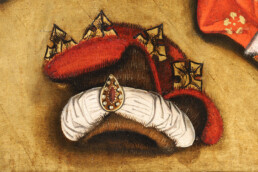
Rückblick auf das Begleitprogramm von Dr. Daniela Blum
Das Begleitprogramm zu unserer Weihnachtsintervention war vielfältig. Wir hatten neben der Kinderführung und dem Frauengespräch drei Veranstaltungen, die verschiedene Perspektiven auf das Thema des schwarzen Königs an der Krippe geworfen haben. Der Historiker Dr. Christoph Mauntel hat am Dreikönigstag über die Heiligen Drei Könige im Mittelalter referiert, der Philosoph und Theologe Dr. Sebastian Pittl hat postkoloniale Perspektiven auf das Thema entwickelt und schließlich gab es am vergangenen Sonntag ein Gespräch mit dem ehemaligen Präsidenten des Kindermissionswerks Die Sternsinger, Dr. Klaus Krämer und einem afrikanischen Priester, Dr. Gonzaga Lutwama Mayanja. Unsere Erkenntnisse fasse ich in drei kurzen Abschnitten zusammen:
- Der schwarze König ist anders.
Schon früh hat die christliche Deutung aus den Sternsingern aus dem Osten, von deren Besuch der Evangelist Matthäus erzählt, Könige gemacht, und zwar drei. Die christliche Traditionsbildung hat die drei Könige mit drei Kontinenten, also mit der ganzen damals bekannten Welt, identifiziert; mit der Völkerwallfahrt zum Zion, die das Alte Testament verheißt; aber auch mit den drei Söhnen Noahs, von denen einer, Cham, vom Vater verflucht wurde. Diese drei bilden in der mittelalterlichen Tradition eine Varianz ab, drei Lebensalter, drei verschiedene Kleidungsstile. Der hinterste König war in dieser Varianz noch einmal anders, er hat in der deutschsprachigen Kunst seit dem 15. Jahrhundert eine dunkle Hautfarbe. Aber auch in anderen Ländern war er gerne derjenige, der exotisch dargestellt wurde, in der italienischen Kunst etwa hatte er gerne blondes Haar und blaue Augen – im Gegensatz zu seinen braunhaarigen Kollegen. Der schwarze König war in der spätmittelalterlichen Kunst das fashion victim: Er trug elegante burgundische Hofmode und Waffen. Insofern bildete er die spätmittelalterliche Adelswelt am eindrücklichsten ab, ohne Waffen nämlich hätte kein Adeliger seinen Hof verlassen. Der Schwarze war insofern und erstaunlicherweise der am besten inkulturierte König innerhalb des Herkunftsmilieus dieser Bilder.
- Es hängt viel davon ab, wie man Andersheit, Alterität deutet.
In dem schwarzen König kann man viele Traditionslinien erkennen. Im 19. Jahrhundert gab es in Amerika die Tradition, einen Mitspieler im Kabarett schwarz zu schminken. Als eine Art Clown und Tollpatsch trat er auf der Bühne auf. Diese Verulkung schwarzer Menschen steckt hinter dem Vorwurf des Blackfacing, ein Vorwurf, der auf manchen schwarzen König in Krippen und Bildern aus der Kolonialzeit durchaus zutrifft. Auch der schwarze Piet, der niederländische Begleiter des Nikolaus und eine Art gewaltbereiter Knecht Ruprecht, wurde schwarz und mit roten Lippen geschminkt. Man muss diese schwierigen Traditionslinien aber nicht im schwarzen König an der Krippe sehen. Vielmehr gibt es, wie ich dargestellt habe, eine jahrhundertealte Tradition in der christlichen Kunst, die unterschiedliche Menschen an der Krippe versammelt wissen will. Diese integrierende, einladende Geste, also eine positive Deutung von Andersheit, sollten wir neu lesen lernen. Dort aber, wo Darstellungen rassistisch sind oder die Traditionsbildung problematisch, etwa in der Identifizierung des schwarzen Königs mit dem verfluchten Sohn Noahs, sind sie als solche zu benennen und zu diskutieren.
- Menschen sind mehr als ihre Hautfarbe, Kunst ist mehr als Hautfarbe.
Wir haben viel über Hautfarbe in dieser Ausstellung gesprochen und dabei festgestellt, dass sie in der Debatte um den schwarzen König manchmal verabsolutiert wird, und zwar von beiden Seiten. Wo ein linker Diskurs aus dem angloamerikanischen Milieu den Blackfacing-Vorwurf erhebt und jede Form eines dunkelhäutigen Königs als rassistisch versteht, fokussiert sie genauso auf die Hautfarbe wie die rechtskonservativen Stimmen, die auf dem Erhalt jeder europäischen Traditionslinie bestehen, selbst da, wo sie rassistisch gemeint war und heute als solche erkennbar ist. In afrikanischen Krippen wiederum, da haben wir gelernt, sind oft alle Krippenbesucher schwarz, nur Jesus und Maria sind meist weiß. Eine Fokussierung auf die Hautfarbe allein macht keinen Sinn. Auch hier darf es Unterschiede geben, so wie Menschen unterschiedliche Hautfarben haben.
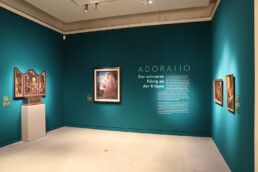
Wanted: Supervisors Exhibition "Vulnerable"
The Diözesanmuseum Rottenburg, in cooperation with “St. Maria as…”, is organising an exhibition in the church of St. Maria, Stuttgart-Mitte, Tübinger Str. 36, following the Katholikentag. The works of the winners of the art competition “Vulnerable. Vulnerable” will be shown. For the exhibition period from
21 May to 24 July 2022
the museum is looking for several supervisors (m/f/d), preferably also students, to supervise the exhibition. The tasks include
Presence in the church room of St. Maria
welcoming visitors to the exhibition and handing out visitor booklets
Selling catalogues
Supervising the technical equipment (lighting, video installations)
To be covered by all supervisors are the periods:
Tuesday to Sunday, 10 am to 6 pm.
A contract for freelance work will be concluded. The hourly rate is 12 €. Please contact us for more information. If you are interested, also in working on certain days or half days, send an email with a short letter of motivation and a CV by 20.12.2022 to:
Dr. Daniela Blum
dblum@bo.drs.de
07472 922 305
